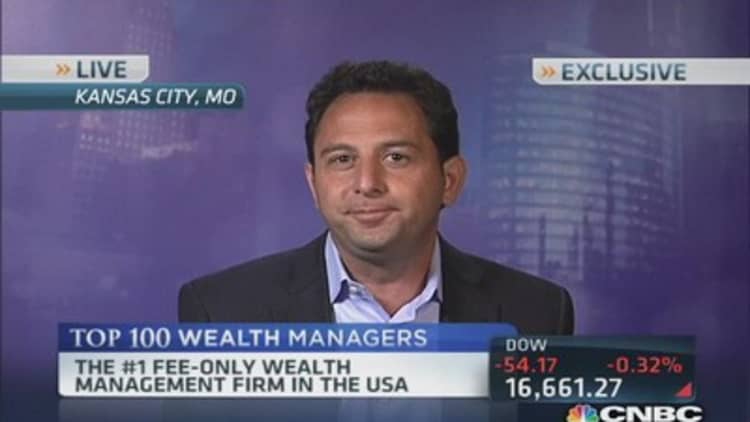
While many advisory firms and investors have recovered or even surpassed their pre-2008 asset levels, they are experiencing this renewed wealth in a substantially different environment.
Consumer households have $39.5 trillion in investable assets, up more than 50 percent since 2008, according to Tiburon Strategic Advisors, a consultant firm to banking, insurance, brokerage and investment management markets.
The CNBC Digital team presents our inaugural list of the Top 100 Fee-Only Wealth Management Firms.
Various studies have also concluded that there are more millionaires and billionaires in the U.S. than there were prior to the 2008 financial crisis.
Nonetheless, there is clear evidence of a widening wealth gap. Tiburon's data show that 8 percent of investors control 73 percent of financial assets and 10 percent control 48 percent of income.

This gap might lead financial advisory firms to opt for technology solutions as a cost-efficient way to serve less-affluent clients.
Already, a better interface between client-facing and back-office systems has created an ease of use that advisors and clients have come to expect in this need-for-immediacy cyberworld.
Read MorePoll finds advisor clients ready to retire
If they aren't doing so already, advisors will increasingly need to use digital marketing and blogging to reach new clients and stay connected to current ones, according to Tiburon.
Mobile apps, client portals and video teleconferencing are all becoming required parts of advisors' marketing and service models, said Tiburon analysts.
Technology has also created more options for Web-savvy investors and, thus, more competition for financial advisors. Wealth management delivery soon will be changing thanks to the emergence of so-called robo-advisors.
Industry pundits believe that robo-advisors will increase the pressure on advisors to charge lower fees and that individual investors will begin to expect more transparent fee structures.
Read MoreHow to pick a financial advisor
Investors are simply more Web-savvy than in the past, according to Cerulli Associates. The research firm reported that 51 percent of investors recently surveyed consider themselves "actively involved" in their portfolios, compared with 39 percent in 2010.
And these are not just cybersavvy youth, but investors of all ages. The 30- to 39-year-old group uses an average of three online services in their financial relationships, while those over age 70 use 2.8.
Robo-advisors drive change
The newest kids on the block in this automated investment service space—including Betterment, Wealthfront and Learnvest—may force advisory firms to find new ways to interact with their clients, pundits say.
To that point, a variety of wire houses and registered investment advisors are using some version of automated services to attract and acquire new, less-affluent clients or to retain them, according to Aite Group, a financial research and consulting firm.
Read MoreAdvisor survey: Stocks still tops
Many of these firms are also using data analytics to more specifically tailor their services to various tiers of clients, Aite Group researchers said.
Hybrid model gets nod
Man and machine is not the only new hybrid model in the wealth management space: Some advisors are opting for a dual registration as both a registered investment advisor (RIA) and a broker-dealer. This allows the firms to conduct a fee business and affiliate with an independent broker-dealer for access to commission products—and back-office services.
While the RIA channel holds more assets than dually registered advisors, Cerulli Associates submits that the hybrid model may become more appealing over the next several years. In fact, in 2012, the asset growth rate in the hybrid space was, at 21.5 percent, nearly double that of the pure RIA channel, at 11.5 percent.
The dual model has historically been looked at as a stepping stone to an RIA business, Cerulli reported. However, it's becoming more permanent and legitimized as a channel, the firm said.
"We see big firms going that way," said Alois Pirker, research director for Aite Group's wealth management practice. "If you put yourself on one side or the other, you will cut out opportunity."
Read MorePicking the right advisor for you
Another issue facing wealth management firms is the aging of the financial advisor population.
The average age of advisors in the country is now 50.9 years, with 43 percent of advisors over age 55 and just 11 percent under 35 years old, according to industry reports.
Acquisition is what happens when there is no succession plan.Eric Schwartzchairman and CEO, Cambridge Investment Research
Based on the expected number of retiring advisors, the entrance of new advisors to the industry and the growth in demand for financial advice, consulting firm Moss Adams has estimated that the industry could face a shortfall of more than 200,000 advisors by 2022.
RIAs most vulnerable
While the industry as a whole faces a looming talent shortage, RIAs—particularly solo practitioners—are the most vulnerable. Most of them lack the resources to recruit and train young people and various studies show that just 20 percent to 30 percent of all firms have any type of succession plan in place.
They can sell gradually to next-generation hires, which ensures client continuity, said Eric Schwartz, founder, chairman and CEO of Cambridge Investment Research. Or they can sell on the open market at the last minute. "Acquisition is what happens when there is no succession plan," he said.
Schwartz's firm, which has been credited with pioneering the hybrid commission/fees broker-dealer model, has started Continuity Partners Group, which is designed to help his client firms manage succession.
—By Pamela Black, Special to CNBC.com.





